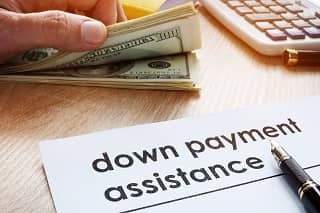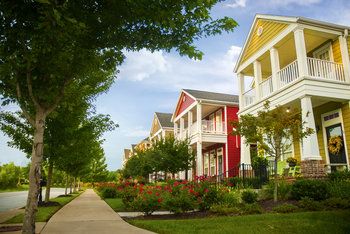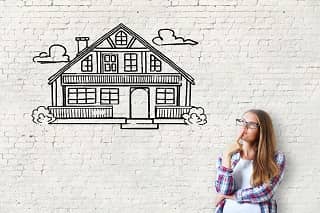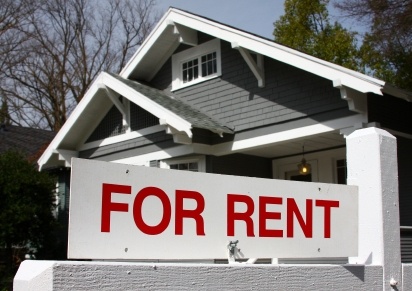 When you buy a home, some financial experts recommend making the largest down payment possible, while others suggest financing as much of your purchase as possible. The right answer depends on market conditions and your circumstances.
When you buy a home, some financial experts recommend making the largest down payment possible, while others suggest financing as much of your purchase as possible. The right answer depends on market conditions and your circumstances.
"It's important to ask the right questions about how various down payment amounts will affect your mortgage insurance and mortgage payments," says Keith Gumbinger, vice president of HSH.com. "You need to figure out if it's worth begging your parents for a certain amount of cash so you’ve got enough money to make a larger down payment, or whether a smaller one will do."
Before you resort to the Bank of Mom and Dad for down payment assistance, whether that be gift money or a loan, it might help to know the pros and cons of a large down payment, and some possibilities for raising this up-front money.
What is the average down payment on a house?
According to the National Association of Realtors 2022 Profile of Homebuyers and Sellers, the typical downpayment for first-time homebuyers was 6% of the home’s purchase price. For repeat buyers, who often have equity to leverage, the downpayment amount rises to 17% of the purchase price.
While 20 percent of the purchase price is a traditional target for a down payment, loan programs from Federal Housing Administration (FHA) and conforming loans (conventional mortgages backed by Fannie Mae and Freddie Mac) both allow for much smaller down payments.
In fact, conforming loans can have minimum down payment requirements as low as 3 percent of the sales price of the home, though people generally make a larger down payment on a conventional loan for a variety of reasons. It’s also technically possible to put no money down, too, as VA loans (Department of Veterans Affairs, available to service members and veterans) and USDA loans (U.S. Department of Agriculture-backed loans, serving mostly rural areas) don’t require a downpayment at all. Like FHA’s upfront mortgage insurance premium, USDA and VA loans do have percentage-based guarantee or funding fees that must be paid. These are usually financed into the loan amount, and help protect these programs against loss.
The typical size of a down payment varies greatly depending on the local real estate market. For example, it's common to see lenders require down payments of 20 percent from jumbo loan borrowers. In some cases, the down payment required will depend on the type of loan you choose; where lenders often sell fixed-rate mortgages soon after they are originated, most lenders hold adjustable-rate mortgages (ARMs) in their own portfolios of loans (and so accept all of the loan’s risk). As such, ARM lenders may require a 10% down payment or more for this type of loan.
According to a survey by Realtor.com, in the first quarter of 2023 the median down payment size in the U.S. was 13% of a home’s purchase price. Down payment sizes in places such as El Paso, TX were as small as 5.4% while home buyers in the San Jose-Sunnyvale-Santa Clara, CA metro area plunked down an average of 22.9 percent when buying a home.
Why such wide differences? In large part, it is because home prices in expensive markets such as San Jose often exceed the conforming loan limits for the area; lenders often require more sizable down payments on private-market jumbo loans, and most homebuyers in these markets aren’t eligible for government-backed or conventional low down payment loan programs. In some cases, borrowers in these markets make sizable down payments in order to get under the local conforming loan limit in order to have access to lower cost loan options or fixed-rate mortgages. In these high-cost markets, this compounds the difficulty of saving for a down payment -- not only are home prices higher, but a greater percentage of the price may need to be paid upfront.
Fortunately, in many areas of the country home buyers have some flexibility as to the size of their down payments. If you have a choice, is it better to put a large down payment on a house, or save your current resources by borrowing as much as possible?
Is it better to put a large down payment on a house?
According to Fannie Mae, the biggest obstacle to first-time buyers is coming up with money for a down payment and closing costs. So, doesn't it make sense to lower this hurdle as much as possible by minimizing the down payment?
Maybe, but there are also several benefits to a larger down payment.
Why you should put 20 percent down on a house
Here are six advantages of making a house down payment of 20 percent or more.
1. Smaller home loan balance. A larger down payment means starting out with a smaller loan amount, which has a few advantages. One of these is that it creates a cushion of home equity even if housing market values decline. That could make the difference in being able to refinance or sell your home in the years ahead.
2. Lower mortgage rates. One way mortgage lenders measure risk is through the loan-to-value (LTV) ratio. The smaller your down payment, the higher your LTV ratio is and the riskier your loan appears. Lenders tend to compensate for making riskier loans by charging higher interest rates, so you might be able to qualify for a lower interest rate and lower monthly payments if you lower your loan’s LTV ratio with a larger down payment.
3. Less interest expense. The above two effects of a larger down payment -- making loan balances smaller and allowing for better interest rates -- combine to reduce the total interest you pay over the life of a loan. A mortgage calculator can show you the total interest you'll have to pay so you can see how much a lower loan amount would save you in the long run.
For example:
Pay extra $50,000 up front. Doubling a down payment on a $500,000 loan from 10 percent to 20 percent means paying an extra $50,000 up front.
Save more than $96,000 long-term. On a 5 percent 30-year mortgage, that higher down payment means paying $96,627.89 less over the life of the loan -- $50,000 in less principal repayment plus a total of $46,627.89 less interest.
4. Reduced private mortgage insurance premiums. Mortgage insurance covers the risk of borrowers not repaying their loans. Since this risk is greater for mortgage loans with higher LTV ratios, the size of your down payment can affect how much mortgage insurance you have to pay, how long you have to pay it, and the size of your premiums.
5. Positive budgeting experience. Saving for a down payment may be challenging, but it will also allow you to practice the budget habits you'll need in order to make your ongoing monthly mortgage payments. Think of saving for a down payment as a trial run to see how much room there really is in your monthly budget.
6. More manageable monthly payments. A number of the above factors - reducing your loan balance, mortgage rate and mortgage insurance premium - can contribute to making your monthly payments lower. This is another good use for a mortgage calculator - it can show you how much less of a burden your monthly payments will be if you start off with a larger down payment.
How best to allocate limited funds for downpayment and closing and manage PMI costs?
Use HSH's Down Payment Decisionersm Calculator
Disadvantages of a large down payment
While there are good reasons to consider a large down payment, you should also be aware of four potential drawbacks.
1. Longer time to enter the market. The months or years spent saving for a large down payment can delay your chance at homeownership. This means paying rent for that extra time, and if housing prices are rising rapidly in your area, it could result in the local market getting away from you. You can see what's happening with home value trends in 400 metropolitan areas with HSH's Home Value Tracker.
2. Less short-term flexibility. Using up all your savings to increase your down payment can backfire, since buying a new home often means dealing with unexpected expenses. As Joseph Montanaro, a financial planner with USAA Enterprise Affairs explained to HSH.com, "it's critical for homeowners to have a healthy emergency fund in place to deal with home maintenance and repairs. A smaller down payment could allow you to maintain an emergency fund, pay down high-interest debt, or utilize the funds for other goals. However, making a smaller down payment should not be an approach to buy a home you can't afford."
3. Interference with investments or retirement saving. Money you accumulate for a down payment can take away from money you put toward other goals. For example, you may have to cash in some long-term investments to come up with a down payment, or putting aside money for a home might restrict your retirement or college savings. Whenever you look at the benefits of a large down payment, you should also take into account the opportunity cost of diverting that money from other things.
4. Benefits take a while to add up. Many of the benefits of a large down payment reward you more in the long-term than in the short-term, which may not be much use to you if you don't plan to stay in the house long. Scott Davis, a Washington DC-area mortgage manager advised HSH.com that "your first question should be how long you intend to live in the house, because if you plan to leave in a few years it may not make sense to put in a lot of extra cash."
The pros and cons of a large down payment encompass a number of factors, including your local real estate market, your financial situation and your long-term goals. Before you’re ready to jump into the market, take some time to consider your down payment options; some choices will be affected by the type of mortgage you choose, and others by your individual situation, including your credit score. Even if you can make a larger downpayment, there can be times when putting less money down offers advantages, too.
Once you understand whether a large down payment makes sense for you, the next step is to figure out how to come up with the money you need.
5 Ways to get a down payment for a house
Here are some options for raising the down payment amount you need:
1. Personal loan for down payment on a house. While it is possible to take on a personal loan in addition to your mortgage to come up with a down payment, there are several problems with this. Some mortgage programs restrict you from borrowing for a down payment, and if you do it is likely to impact both your debt-to-income ratio and your credit score. Those are major factors in whether you qualify for a mortgage loan, and if so, what interest rate you get. Speaking of interest rates, the rate you get on a personal loan being used as a down payment loan is likely to be much higher than your mortgage interest rate.
2. Down payment assistance. This is where the Bank of Mom and Dad may come in. There are also a variety of state-sponsored home buyer programs that may contribute toward your down payment; eligibility requirements vary, but most are aimed at first-time homebuyers (those who haven’t owned a home in at least three years).
3. Sale of assets. You may have some investments you can access, some valuable jewelry or collectibles just gathering dust or perhaps it's time to sell off something like a boat or a second car to raise money for a down payment. This is a case of weighing the long-term benefit of holding onto the asset against the benefit of getting into a home sooner and/or with a larger down payment.
4. A 401(k) loan. It is possible to borrow from your 401(k) plan, in some cases to fund a larger down payment. Because this allows you to access 401(k) money without incurring a tax penalty, some people view it as a cost-free source of money for a down payment -- after all, what could be the harm in borrowing from yourself? Well, tapping into your retirement assets even on a temporary basis is likely to slow your ability to build your nest egg, and worse, some 401(k) plans require you to pay back the loan immediately if you leave your employer.
5. Budgeted savings. Setting a little extra aside from your household budget month-after-month is the slow-and-steady way of raising money for a down payment. It's great practice for the extra financial burden a mortgage payment is likely to represent. However, in real estate markets where prices are rising quickly, this slow-and-steady approach might cause you to miss an opportunity.
Be sure to consider both the short- and long-term ramifications before making the decision to commit a large down payment or even buy a home with cash. Like many financial decisions, the size of your down payment is often a trade-off between immediate and long-term benefits. Ultimately, getting the best mortgage for your situation means finding the right combination of loan options while figuring out how to spread your cash among your down payment, closing costs and any required reserves.
Calculate the total costs of an FHA loan and compare it against low downpayment offerings from Fannie Mae and Freddie Mac.
This article was updated by Keith Gumbinger and Richard Barrington.




Thank you, this website is very helpful.